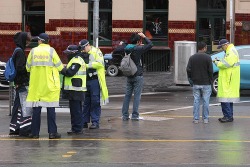General pedestrian rules

A pedestrian must obey the rules of the road set out in the Road Safety Rules 2009. Some of the more notable rules state that a pedestrian must:
- not cross the road within 20 metres of a pedestrian crossing (you must use the crossing)
- not enter a crossing against a flashing red or a solid red traffic crossing light
- use the shortest or most direct route across a road
- not walk along or fail to give way when crossing a bicycle path
- not cause a traffic hazard by moving into the path of a driver
- keep to the far side of a road facing oncoming traffic, when walking along a road where it is not practicable to use the footpath or nature strip.
Further detail on the road rules relating to pedestrians is provided on the VicRoads website, along with information on pedestrian safety.
When to give way?

-
When turning at an intersection, a driver has to give way to any pedestrians crossing the road the driver is turning into. The exception to this rule is at a roundabout, where the driver does not have to give way unless there are crossings provided for pedestrians.
-
Drivers must not block a pedestrian crossing or children's crossing - they must ensure the road beyond is clear to enable them to pass over the crossing. This does not apply where there is a pedestrian crossing immediately before an intersection.
- When leaving a driveway or car park, drivers must give way to pedestrians on any footpath, path or nature strip.
- When using a slip lane to leave a main road or turn left on a road drivers must give way to pedestrians.
- In a shared zone drivers must give way to pedestrians.
- In addition, road rules 197 and 198 state that a driver must not stop on a footpath in a built up area or stop in a location that obstructs access to a footpath.
Motorist duty of care

Motorists have a duty of care to watch for pedestrians on the roadway. This was considered by the Supreme Court of Queensland in Perfect v MacDonald & Anor 2012. The Court noted "in pedestrian cases, typically a heavier share of responsibility falls on the motorist even if the degrees of departure from the standard of reasonable care be more or less equal." In this particular case a pedestrian was struck while standing at least partially on the road, but the Court ordered the driver and her insurance company to pay him $124,000.
The motorist's duty of care does not appear to be reflected in the official perspective on pedestrian crashes. Rather there may be a subtle blaming of the victim - or at least not blaming the driver. The Bayside Review Local 23 Jan 2013 reported on an incident where an elderly lady was killed and another was injured when a car was driven into a wall of the Sandringham Library in Melbourne. Yet no apparent blame is attributed to the driver and the Police response is to warn everyone else, including pedestrians, to be careful! In 2008, Victoria Police claimed drivers were at fault in only 4 of 39 pedestrian deaths (see page 65, Safe Speed: promoting safe walking and cycling by reducing traffic speed). However TAC research Exploring the pedestrian crash problem from the perspective of injured pedestrians found that drivers were generally at fault in a sample of about 200 crashes.
Some argue that we should refuse to accept pedestrian deaths as 'part of life' and clearly place the onus of responsibility to avoid accidents on drivers, who are responsible for the hazard - see Walking is Not a Crime: Questioning the Accident Axiom and Strict liability: why it's a life-saver.
Walking related policy legislation
A range of other legislation is relevant to council administration of transport, including walking.
- Transport Integration Act 2010, requiring all Victorian transport agencies to work together towards a common goal of an integrated and sustainable transport system. Land-use agencies, including councils, are required to have regard to the Act when making decisions that impact on the transport system.
- Road Management Act 2004, designed to create a coordinated system of management for roads in Victoria.
- Disability Discrimination Act 1992, requiring compliance for access, including access to public transport.
- Public Health and Wellbeing Act 2008, requiring local government to produce a municipal health plan that can support initiatives to increase physical activity, through walking. The Victorian Public Health and Wellbeing Plan 2019-2023, developed in accordance with that legislation, has four focus areas including "increasing active living."